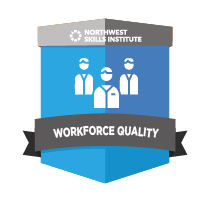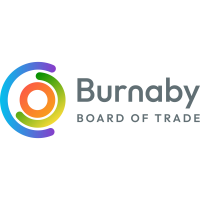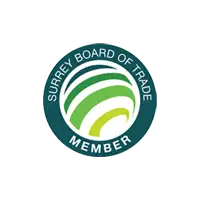
Team building strategies for your organization
Did you know that training your employees in team building strategies can translate into real benefits for your organization? Studies have shown that when employees develop goal setting, interpersonal, and critical thinking skills, productivity increases and employee turnover decreases.
The NWSkills Team Building for Success courses focus on the skills your workforce needs to succeed: group communication, diversity, meeting strategies, problem solving, decision making, conflict management, leadership, training and development.
If you’re not sure which courses to take, our learning and development team can conduct an organizational needs assessment to help you map out a learning path that targets the skills your workforce needs.
To get the Team Building Certificate, students will have to complete all fundamental courses plus electives accumulating at least 6 hours of training.
See below to learn about the communication courses and certificates offered by NorthWest Skills Institute.
Admission Requirements:
- Recommended CLB 7 (Canadian Language Benchmark)—Equivalent to IELTS 6 OR TOEFL 77-99
- Have access to a device that meets the system requirements to use Northwest Skills Institute online courses.
Course Outline
Prerequisites
These courses are a tremendous opportunity for you to learn skills that are needed for employment in growing industries across the country. Your participation in these courses is a unique opportunity for you to set a path for success on your career journey.
By the end of this course, you will be able to
- Understand the value of this educational opportunity
- Define the three steps to greatness
- Explain the importance of certifications
The first page of a course is always the objectives page. The objectives page introduces the course and lists the learning objectives of the course.
This course explains how a course is structured and how you can interact with the course.
By the end of this course, you will be able to
- Describe the different sections of the screen in a course
- Understand how to navigate through a course
- Explain how to use a knowledge check
- Describe how to use a drag and drop activity
- Describe how to use an input box activity
The learning management system (LMS) allows you to easily navigate your online education. Using the LMS, you can access learning paths, study guides, and assessments.
By the end of this course, you will be able to
- Understand how to use the LMS
- Explain how to launch a course
- Describe how to take an assessment
An online course is a great way to learn, but it is different from taking a class in a classroom. This course provides tips to help you succeed in an online learning environment.
By the end of this course, you will be able to
- Set a study schedule
- List tips for retaining the information you have studied
- List tips for taking quizzes
Foundational Courses
No matter how responsible, organized, or charismatic you are, if you don’t work well with others, you won’t have success – on or off the job. In this course, you’ll learn about the advantages of working with other individuals. You’ll also discover the science of group dynamics, as well as the difference between primary and secondary groups. Finally, you’ll find out about the formal and informal roles group members may take on.
By the end of this course, you will be able to
- Understand the importance of working well with others
- Define a group
- List the advantages of group work
- Define group dynamics
- Describe the characteristics of a group system
- Describe the difference between primary and secondary groups
- Describe the difference between formal and informal group roles
Group members need to communicate effectively and collaboratively in order to accomplish the group’s common goal. In this course, you’ll learn how to communicate with group members so that what you’re saying is correctly understood. You’ll learn how to avoid common listening traps. You’ll also discover how to listen for understanding.
By the end of this course, students will be able to
- Understand the importance of effective communication
- List guidelines for effective communication
- Describe how to avoid sending mixed messages
- Identify common listening traps
- Understand how to listen for understanding
For a group to successfully collaborate to accomplish its goal, members must be able to get along and work together. In this course, students discover how trust, cohesiveness, support, and ethics affect group climate. Student will also learn how to become a better and more effective group member.
By the end of this course, students will be able to
- Describe the difference between a positive and negative group climate
- List factors that affect group climate
- Understand your role in becoming a better group member
- Understand the importance of being cooperative and assertive
- List guidelines for effective group discussion
While not all groups are considered teams, all teams are considered groups. For a team to succeed, it’s important that its members work together as a unit. In this course, you’ll learn about the different life stages of a team. You’ll also find out what you can do to help encourage team cohesiveness.
By the end of this course, you will be able to
- Define team
- Describe the four life stages of a team
- Understand the reasons teams may struggle
- Define synergy
- List ways to build a cohesive team
- Understand how to set ground rules
- List ways to encourage teamwork
Fundamental Courses
Nothing destroys productivity and teamwork like a meeting gone bad. In this course, you’ll discover when you really need to attend a meeting and what you can do to get the most out of the meeting.
By the end of this course, you will be able to
- Describe why it’s important to get the most out of the time spent in meetings
- List common reasons why meetings are disliked
- Identify when a meeting is not necessary
- List times when a meeting should be held
- Describe what you need to do to conduct an effective meeting
- List what you need to do to prepare for a meeting
- Understand the importance of an agenda
- List the topics ground rules need to cover
- Understand what you need to do when you’re the one leading the meeting
- Describe how to handle difficult personalities
- Understand how you can overcome your own anxiety in a meeting
Everyone is different, and not everyone in a group is going to think the same way or come from the same background. In this course, you’ll learn guidelines for working in a diverse group.
By the end of this course, you will be able to
- Understand why being different from you isn’t a negative
- List ways to respect diversity
- Define culture
- List the advantages of diversity
- List the disadvantages of diversity
- List strategies for working in a diverse group
- Describe ways to overcome language barriers
Creativity allows people to invent, communicate, and problem-solve at a higher level. In this course, you’ll learn about two tools that can help spark creativity: brainstorming and mind- mapping.
By the end of this course, you will be able to
- Define creativity
- List ways to increase creativity
- Describe the process of brainstorming
- Describe the process of mind-mapping
- Understand how to piggyback on an idea
Problems are a part of everyday life, so it shouldn’t surprise students when their group encounters one. In this course, they will learn how to deal with problems whenever it comes their way.
By the end of this course, students will be able to
- Understand the effects of unsolved problems
- Describe common problem-solving pitfalls
- Learn problem-solving techniques
- List common spelling errors
- Understand how to use the IDEA method to solve problems
- Describe how to use the S-T-P model of problem-solving
- Understand how to choose the right solution
Group decision-making is hard. In this course, you’ll discover the special considerations you need to think about during group decision-making. You’ll find out about what consensus really is and which traps you need to avoid. Finally, you’ll learn about groupthink and how you can prevent it.
By the end of this course, students will be able to
- Understand why group decision-making is difficult
- List the advantages and disadvantages of group decision-making
- Describe different decision-making approaches
- Identify common mistakes in reaching consensus
- Describe how to reach a true consensus
- Define groupthink
- Identify the signs of groupthink
- Understand the reasons for bad decision-making
- Describe the process for making good decisions
- Understand how to make an ethical decision
In this course, you’ll find out why conflict occurs. You’ll learn how to identify the differences between positive and negative conflict as well as the common strategies for handling a conflict. You’ll also discover the six steps involved in successful collaboration. Finally, you’ll find out what you can do to help resolve group conflict.
By the end of this course, you will be able to
- List the reasons why conflicts occur
- Describe the differences between positive and negative conflict
- Identify negative behavior
- List the effects of negative conflict
- Decide if and when to address conflict
- Understand the importance of listening in conflict resolution
- Implement conflict resolution strategies
- Engage in successful collaboration
- Describe what you can do to help resolve conflict
Leaders have a tremendous impact on a group’s success in reaching its goals. In this course, you’ll discover what leadership is, as well as the traits of successful leaders. You’ll also learn how you can develop leadership skills in case you ever find yourself in a leadership position.
By the end of this course, students will be able to
- Describe the role of a leader
- Explain why leadership is important
- List ways to develop leadership skills
- Explain the importance of communication in leadership
- Identify the traits of successful leaders
- Understand how to create a plan and set goals
Virtual groups rely on technology to allow people in multiple locations and time zones to communicate and collaborate. Virtual groups take advantage of a multitude of technologies, including emails, instant messaging, and teleconferences. In this course, you’ll discover what you need to do as a virtual group member.
By the end of this course, you will be able to
- Describe a virtual group
- List the different types of virtual communication
- Describe the different virtual communication tools
- Understand the challenges of virtual group communication
- List ways to get the most out of working in a virtual group
- List the advantages and disadvantages of virtual meetings
- Describe the guidelines for conducting virtual meetings
- Describe the guidelines for using different types of conferencing tools
Teamwork is an action performed by a team toward a common cause or goal. Teamwork is a crucial part of any business.
By the end of this course, you will be able to
- Define the term team
- Define the term teamwork
- Describe the seven common elements of teams
- Identify the advantages of teams
- Describe functional teams
- List the aspects of winning teams
Team building refers to a varied assortment of actions used in all aspects of life for the purpose of improving a group’s performance.
By the end of this course, you will be able to
- Define team building
- List the purposes of team building
- Identify the purpose of team building activities designed to build team purpose
- Identify the purpose of team building activities designed to improve group dynamics
- List the four common types of team building exercises
In today’s workplace, employers depend on high performance teams to help them remain competitive. Teamwork has many benefits for employers and employees alike, but developing an efficient team takes time and hard work.
By the end of this course, you will be able to
- Explain how teamwork benefits an employer and employees
- Define four types of teams
- Describe the characteristics of a successful team
- Identify three basic team roles
- Describe the five stages of team development
Teamwork involves a lot of responsibility and cooperation. Team members need to be able to work efficiently and effectively in order to meet the expectations set for and by them.
By the end of this course, you will be able to
- Describe how to develop a SMART goal
- Identify the six steps of the problem solving process
- Define four decision making procedures
- Explain how to avoid and settle conflict
Strong training and development programs benefit employers and employees alike. These programs may vary from company to company, but all function according to a similar set of guidelines and principles.
By the end of this course, you will be able to
- Explain the worth of effective leaders and trainers
- Identify the steps involved in creating a training program
- Define different methods of training
- Describe the importance of training in the manufacturing industry
Preparing you for success
The Northwest Skills Institute is an industry focused training organization.
Our programs are geared specifically for industry, making students more qualified and READY FOR WORK.























